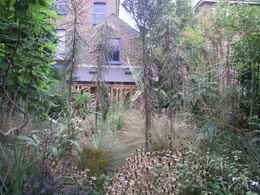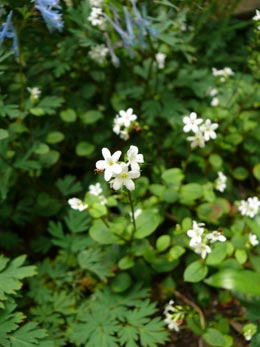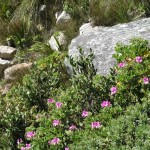Northern European planting design as a prototype for NZ
This is the second part of a two-part essay by Philip Smith (o2 Landscapes) at the International Plant Propagators’ Society conference in Auckland. To read Part one please click here.
Adaptation of the Northern European naturalistic model to New Zealand
Germany had its chief pioneer in Karl Foerster. Designers and plantspeople who followed him developed variations upon a garden style which is informed by (and respectful of) nature. New Zealand has been fortunate to be the scene of the pioneering work of Terry Hatch, who has applied similar effort to the evolution of garden style within New Zealand, through the observation of native plants within their natural ecologies, exotic plants within their own habitats (as in his extensive studies on South African plants), and the performance of exotic plants within the pseudo-ecologies of our own gardens. I am interested in further developing the example set by Terry’s work to lay down a really satisfying paradigm for New Zealand landscape design. This paradigm would combine an appreciation of the natural character of our indigenous landscapes with the seasonal interest/variation of selected exotic perennials, trees and shrubs.

Celmisia
Time spent within natural landscapes in New Zealand and abroad provides a sound basis for understanding the rhythms and orders of plants within their natural habitats. For adapting an integrated garden style to New Zealand, one needs to consider the character of the region of New Zealand in which one is making a garden. Within New Zealand, we do not have many natural grasslands, like the prairies or Caucasian grasslands that the work of many German or Dutch designers emulates. Even South Island grasslands usually have a shrubby component to them. Therefore, the composition of our gardens needs to reflect the nature of our own landscapes.
Many native shrubs, such as Melicytus obovatus, Sophora prostrata, or Olearia nummulariifolia, have a natural fineness and scale which is similar to many of the grasses favoured by northern European designers.
These kinds of shrubs can actually improve the concept of the integrated garden by providing informal structure, the lack of which is a common problem with flower gardens. London-based landscape designer, James Fraser, has developed a style of garden that utilises both the northern European tradition and more substantial elements, such as his trademark usage of lancewoods and other New Zealand trees and shrubs. Interestingly, James hadn’t seen toothed lancewood in the wild until recently, but the ecology within the wild shows marked similarities with the compositions of James’ designs, particularly in the depth established through various levels of vegetation.

Fraser garden
A major difference between New Zealand and northern Europe is that a large number of our natural landscapes are still intact in a relatively original manner. Gardens within New Zealand can play an important role in awakening people to the nature of our wild landscapes, and to the existence of the wide range of plants that exist in the flora. Ironically, there is potentially more chance of advocating for rare and endangered species within a garden style that is not exclusively native. That is because there is less pressure on the plant to be exceptional.
Contemporary gardens are full of ‘star’ plants; plants that tick all the boxes when viewed in isolation.
However, what is really important is how plants are viewed in association. That is what provides the profound beauty of natural landscapes; the unspectacular sedge at the base of an Astelia which has a strong form, or the quietly creeping Nertera and unassuming divaricate Coprosma which stand next to the remarkable Dracophyllum. Natural planting associations have rhythms to them, which we read when we view them. Many native species which are endangered in the wild do not have appeal as ‘star’ plants, yet deserve to be known, not just for their conservation values, but for the quiet charm that they can lend to planting associations. The best example of a change in perception within recent times is the manner in which divaricate shrubs have risen from anonymity to become widely used.

Myosotis petiolata
One of the most difficult problems of native plant conservation concerns the restoration of herbs. Herbs usually have less robust systems than woody plants, and are often relatively short-lived. To add to their problems, they often prefer comparatively open habitats that weeds and humans prefer. Colin Meurk, of Landcare Research, has carried out a good deal of interesting work regarding conservation of the New Zealand herb flora; some of which concerns their inclusion within the human landscape. This is an interesting approach that acknowledges the central place of people within so much of the New Zealand landscape. Meurk goes as far as to suggest that even stone walls within cities can provide habitat for significant native species. Such perception is inspiring, as it looks to bridge the problem of relevance; presenting people with native plants in such seemingly artificial circumstances has a dynamic quality to it, in the vein of the philosophy of Kisho Kurokawa. Acknowledgement of the legitimacy and inevitability of the modified landscape (within its place) actually progresses us beyond simplistic arguments regarding the ideal nature of our landscapes.
An important point regarding the making of integrated gardens within New Zealand is that exotic flowers that are utilised within such a style need to meet the criteria of having zero or negligible potential as a weed, and be ecologically appropriate. This involves striking a difficult balance between being able to survive under pseudo-natural terms, without the capacity to disperse further and affect significant natural landscapes. It is in providing a better understanding of this that Terry Hatch has taught me a lot.

Table Mountain
In looking for plants for this role, it makes sense to look towards regions with similar ecologies to ours. For this reason, South Africa (a special interest of Terry’s) – and more specifically the Cape region – is especially appropriate. Geophytes (bulbs, corms and tubers) can handle emerging through or beneath a framework of native vegetation. Plants such as Albuca nelsonii, Gladiolus species, Freesia or Haemanthus make excellent additions to a native framework, as they present flowers whilst not dominating in form.
A category of plants over which caution needs to be exercised is exotic climbers, as this plant type presents some of the worst culprits for environmental weeds. However, one category of climbers that I have a special interest in (particularly in association with divaricate shrubs) is the the Viticella group of Clematis, and its many varieties. Their shades of white, red, pink or purple can provide another dimension to native shrubs and trees. Seasonal flowers can also be introduced through the use of certain exotic trees or shrubs, such as species and varieties of Magnolia, Lagerstroemia, or Gordonia. Such species do not need to be mixed into native tree plantings, but may be used as specimen counterpoints, within adjacent lawns, or above lower plantings. There are also exotic species, such as Rhododendron nuttallii, Acer griseum, or various species of Lagerstroemia, whose magnificent bark can provide contrast to native plantings.

Jovellana sinclairii
There exists a huge range of plants that can be used in sensitive association with natives, but landscape designers need to develop work integrating significant exotic species, as lack of commercial interest is making many excellent garden subjects increasingly rare. We have a quandary with regards to exotic species, as conservation is also necessary with the magnificent range of garden plants that visionary nurserymen have introduced to new Zealand (many from travels to the wild in other countries). Due to tightening importation regulations, once we lose such plants, we may not be able to get them back.
An integrated garden style is not just concerned with conservation of native plants and ecologies, but also with continuing the horticultural heritage that we are fortunate to be part of. In this way, it can form a middle ground between nature and culture, and provide us with a stimulating paradigm that values diversity within gardens.

